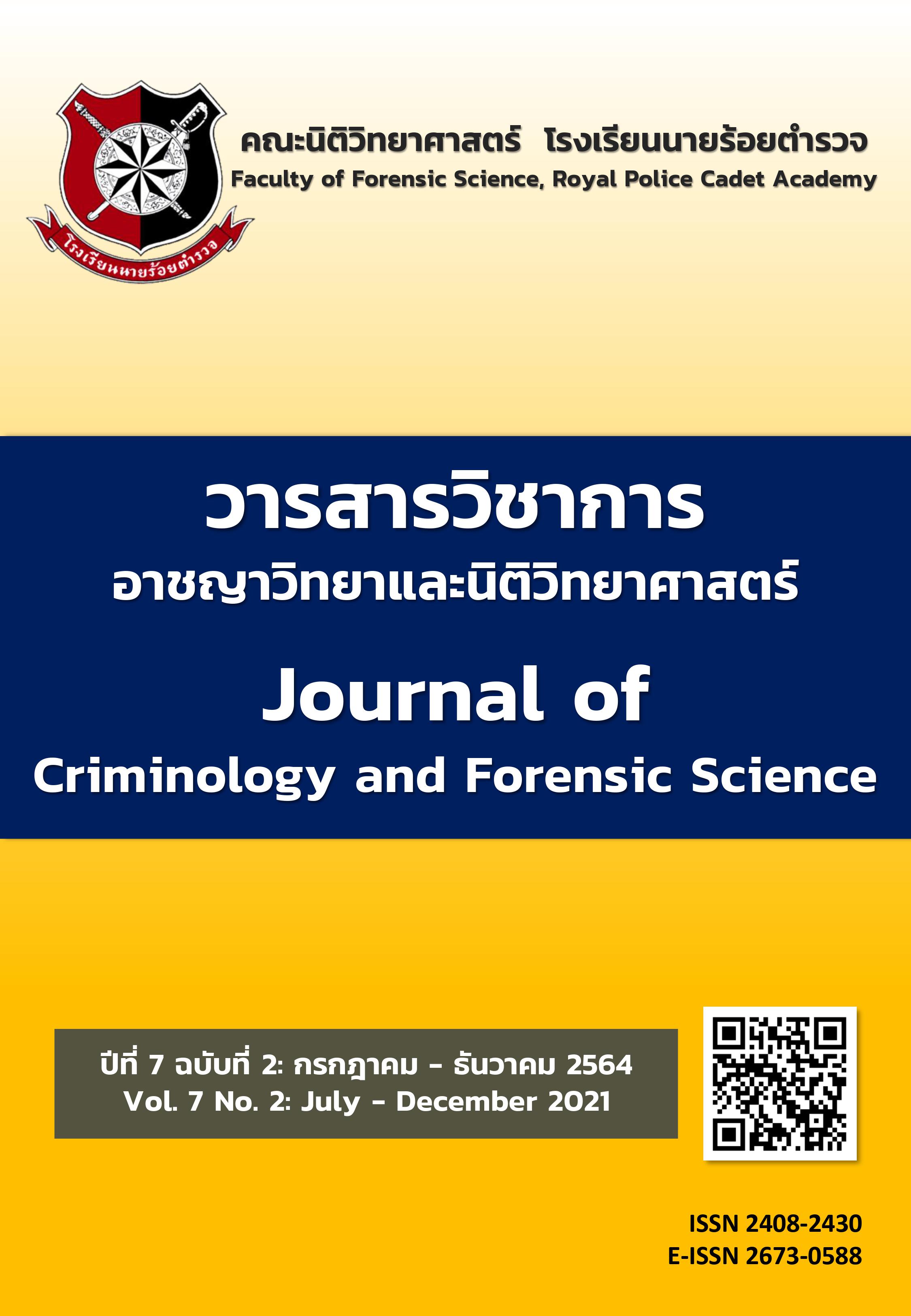แนวคิดเกี่ยวกับการป้องกันอาชญากรรมการล่วงละเมิดทางเพศต่อเด็กทางอินเทอร์เน็ตด้วยเทคโนโลยีปัญญาประดิษฐ์
Main Article Content
บทคัดย่อ
บทความวิชาการนี้มีวัตถุประสงค์เพื่อนำเสนอแนวคิดเกี่ยวกับการป้องกันอาชญากรรมการล่วงละเมิดทางเพศต่อเด็กทางอินเทอร์เน็ตด้วยเทคโนโลยีปัญญาประดิษฐ์ โดยมุ่งเน้นความสำคัญของการป้องกันแก้ไขปัญหาการล่วงละเมิดทางเพศต่อเด็กทางอินเทอร์เน็ต บทบาทของเทคโนโลยีปัญญาประดิษฐ์ในการป้องกันการล่วงละเมิดทางเพศต่อเด็กทางอินเทอร์เน็ต และการประยุกต์แนวคิดเกี่ยวกับการป้องกันอาชญากรรมเชิงสภาพแวดล้อม ซึ่งได้แก่ ระดับการป้องกันอาชญากรรมตามรูปแบบการป้องกันและควบคุมโรคทางสาธารณสุขและแนวคิดการป้องกันอาชญากรรมตามสถานการณ์ เพื่อนำมาวิเคราะห์และอธิบายหลักการทำงานของเทคโนโลยีปัญญาประดิษฐ์ในการป้องกันการล่วงละเมิดทางเพศต่อเด็กทางอินเทอร์เน็ต โดยเปรียบเทียบกับการป้องกันและควบคุมการแพร่ระบาดของเชื้อไวรัสโคโรนา 2019 (COVID-19) ซึ่งแบ่งระดับการป้องกันเป็น 3 ระดับ ได้แก่ ระดับปฐมภูมิ ทุติยภูมิ และตติยภูมิ อันจะนำไปสู่การลดโอกาสในการประกอบอาชญากรรมและการตกเป็นผู้เสียหายจากการล่วงละเมิดทางเพศของเด็ก รวมถึงการเพิ่มช่องทางการเข้าถึงกระบวนการยุติธรรมของเด็กและเยาวชนสำหรับการแจ้งเหตุหรือเบาะแสการกระทำความผิด และการลบทำลายสื่อแสดงการล่วงละเมิดทางเพศต่อเด็ก โดยสภาพแวดล้อมที่มีการป้องกันการล่วงละเมิดทางเพศต่อเด็กด้วยเครื่องมือซึ่งพัฒนามาจากเทคโนโลยีปัญญาประดิษฐ์
Article Details

This work is licensed under a Creative Commons Attribution-NonCommercial-NoDerivatives 4.0 International License.
เนื้อหาและข้อมูลในบทความที่ลงตีพิมพ์ใน วารสารวิชาการอาชญาวิทยาและนิติวิทยาศาสตร์ โรงเรียนนายร้อยตำรวจ ถิอว่าเป็นข้อคิดเห็นและความรั้บผิดชอบของผู้เขียนบทความโดยตรงซึ่งกองบรรณาธิการวารสาร ไม่จำเป็นต้องเห็นด้วยหรือรับผิดชอบใดๆ
บทความ ข้อมูล เนื้อหา รูปภาพ ฯลฯ ที่ได้รับการตีพิมพ์ใน วารสารวิชาการอาชญาวิทยาและนิติวิทยาศาสตร์ ถือว่าเป็นลิขสิทธิ์ของวารสาร วารสารวิชาการอาชญาวิทยาและนิติวิทยาศาสตร์ หากบุคคลหรือหน่วยงานใดต้องการนำทั้งหมดหรือส่วนหนึ่งส่วนใดไปเผยแพร่ต่อหรือเพื่อกระทำการใดๆ จะต้องได้รับอนุญาตเป็นลายลักษณ์อักษรจาก วารสารวิชาการอาชญาวิทยาและนิติวิทยาศาสตร์ ก่อนเท่านั้น
References
Beier, K.M. (2016). Proactive Strategies to Prevent Child Sexual Abuse and the Use of Child Abuse Images: The German Dunkelfeld-Project for Adults (PPD) and Juveniles (PPJ). Cham: Springer. 249-272.
Bracket Foundation. (2019). Artificial Intelligence: Combatting Online Sexual Abuse of Children. Retrieved June 30, 2021 from https://respect.international/ai-combating-online-sexual-abuse-of-children.
Brantingham, P.J. and Faust, F.L. (1976). A Conceptual Model of Crime Prevention. Crime and Delinquency, 22(3), 284–296. Retrieved June 21, 2021 from https://doi.org/10.1177/001112877602200302.
Cornish, D.B. and Clarke, R.V. (2003). Opportunities, Precipitators and Criminal Decisions: A Reply to Wortley’s Critique of Situational Crime Prevention. Crime Prevention Studies, 16, 41-96.
Council of Europe. (2021). Respecting Human Rights and the Rule of Law When Using Automated Technology to Detect Online Child Sexual Exploitation and Abuse.
ECPAT. (2020). Why Children Are at Risk of Sexual Abuse and Exploitation During COVID-19. Retrieved June 10, 2021 from https://www.ecpat.org/news/covid-19-sexual-abuse.
Ekblom, P. (2017). Crime, Situational Prevention and Technology. The Routledge Handbook of Technology, Crime and Justice. 353–374.
EUROPOL. (2020a). Exploiting Isolation: Offenders and Victims of Online Child Sexual Abuse During the COVID-19 Pandemic. European Union Agency for Law Enforcement Cooperation.
EUROPOL. (2020b). Internet Organised Crime Threat Assessment (IOCTA) 2020. Retrieved July 1, 2021, from https://www.europol.europa.eu/activities-services/main-reports/internet-organised-crime-threat-assessment-iocta-2020.
Hassad, R.A. (2020). COVID-19: A Pandemic Preparedness Mindset - Primary, Secondary, and Tertiary Prevention Strategies All Play a Role. Retrieved June 5, 2021 from https://www.medpagetoday.com/infectiousdisease/covid19/85200.
Internet Watch Foundation. (2020). IWF Annual Report 2020. Retrieved June 30, 2021 from https://annualreport2020.iwf.org.uk.
Kongsuwan, S. (2021). MySis: A Chatbot Working as a ‘Sister’ Who Supports Children and Women Facing Violence. Thailand Institute of Justice (TIJ) and The101.world. Retrieved July 3, 2021 from https://www.the101.world/mysis-chatbot/. (In Thai).
National Centre for Missing and Exploited Children. (2021). Reduce Child Sexual Exploitation. Retrieve July 3, 2021 from https://www.missingkids.org/content/ncmec/en/ourwork/impact.html.
Perrot, P. (2017). What about AI in Criminal Intelligence: From Predictive Policing to AI Perspectives. European Police Science and Research Bulletin, 16, 65-76.
Quayle, E. and Koukopoulos, N. (2019). Deterrence of Online Child Sexual Abuse and Exploitation. Policing: A Journal of Policy and Practice. 13(3), 345-362.
Sangtongdee, U., Poengranai, K., and Meephiam, P. (2020). Hashing Technology and PhotoDNA Database in Multimedia Forensics. Journal of Criminology and Forensic Science, 6(2), 181-196. Retrieved June 3, 2021 from https://so02.tci-thaijo.org/index.php/forensic/article/view/244801. (In Thai).
UNODC. (2020). Online Child Sexual Exploitation and Abuse. E4J University Module Series on Cybercrime. Retrieved June 1, 2021 from https://www.unodc.org/e4j/en/cybercrime/module-12/key-issues/online-child-sexual-exploitation-and-abuse.html.
Winters, G.M. and Jeglic, E.L. (2017). I Knew It All Along: The Sexual Grooming Behaviours of Child Molesters and the Hindsight Bias. Journal of Child Sexual Abuse, 25(1), 20-36.
Završnik, A. (2020). Criminal Justice, Artificial Intelligence Systems, and Human Rights. ERA Forum, 20(4), 567-583. Retrieved July 1, 2021 from https://doi.org/10.1007/s12027-020-00602-0.

